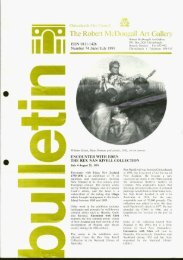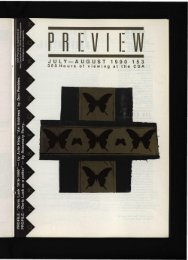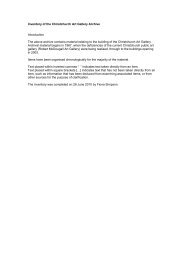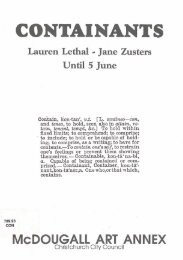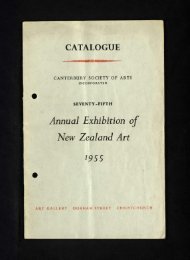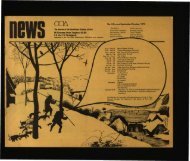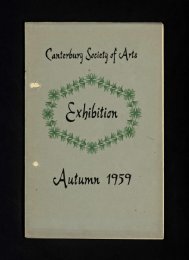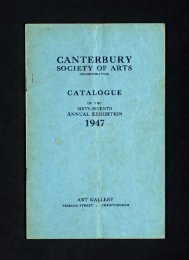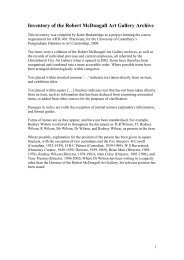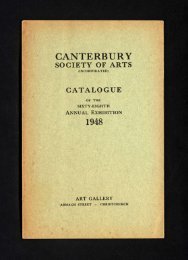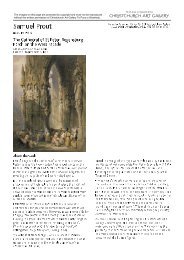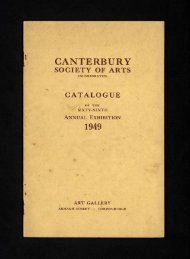Download (2.2 MB) - Christchurch Art Gallery
Download (2.2 MB) - Christchurch Art Gallery
Download (2.2 MB) - Christchurch Art Gallery
Create successful ePaper yourself
Turn your PDF publications into a flip-book with our unique Google optimized e-Paper software.
Space is Place<br />
At first glance, the health of art in public space in Aotearoa<br />
could be judged ruddy. In <strong>Christchurch</strong> there is the flush of<br />
activity that comes with the SCAPE 2008 Biennial and the<br />
commissioning of the first permanent work by the newly<br />
formed civic Public <strong>Art</strong> Advisory Group – Flour Power by<br />
Regan Gentry. Dunedin City Council is inviting proposals<br />
from artists and curators for a new art in public space<br />
programme, and in Auckland a new manager of public art<br />
has been appointed to lead a line-up of activities fulfilling<br />
a refreshed public art policy. Thanks to the work of the<br />
Wellington Sculpture Trust, Wellington City Council,<br />
Wellington Waterfront and Wellington Tenths Trust,<br />
Wellington is now arguably the most densely populated<br />
city in New Zealand when it comes to permanent public<br />
sculptures. It is also ‘home base’ to the national temporary<br />
public art series ‘One Day Sculpture’, which began in August<br />
with works by Maddie Leach and Kah Bee Chow, and runs<br />
through until mid 2009.<br />
However, it is vital that we do not slip into a self-satisfied<br />
malaise. Compared with many other countries we are still<br />
in a period of relative infancy, or at best adolescence, when<br />
it comes to commissioning and resourcing contemporary,<br />
critical, high-calibre artworks in public space. The challenges<br />
are plural: we need to encourage a deeper and broader<br />
understanding of what art in public space can be, while also<br />
sharpening our commissioning and curatorial practices to<br />
be more in tune with the practices of artists, the interests<br />
of audiences and the pressures of urban and suburban<br />
development. Slowly, a breadth of opportunities is emerging:<br />
permanent, temporary, commissioned and self-initiated.<br />
These need to be met with a commitment to prioritising<br />
quality over quantity, and the growth of a more robust<br />
understanding of ‘good practice’ across a range of different<br />
art forms and ways of making.<br />
‘I refute the argument that works<br />
in public space must inevitably be<br />
diluted by the approvals process<br />
and can’t retain their bite or spark.’<br />
Different municipalities currently operate independently,<br />
and with varying levels of commitment, resources and success.<br />
While there are guidebooks and critical texts aplenty (the<br />
majority of which are published offshore), there is a real need<br />
for a set of national policy guidelines to assist local authorities<br />
in formulating their own policies and protocols that are<br />
clear, informed, contemporary and regularly reviewed. An<br />
important model to consider when formulating policy at a<br />
national or local level is the ‘percent-for-art’ system.¹ Recent<br />
research undertaken by the Rob Garrett Contemporary<br />
Fine <strong>Art</strong> consultancy concluded that, internationally, the<br />
most common way for city administrations to resource<br />
their public art programmes is through percent-for-art<br />
funding. Most often this takes the form of a 1–2% levy on<br />
civic capital development budgets, but in some cities, such<br />
as San Francisco, this has been extended to private CBD<br />
developments.<br />
... In many schemes the levy is pooled to create a public fund,<br />
but in other cases the public art budget is levied project-by-project<br />
... Overall the percent-for-art mechanism is favoured because it is<br />
easily understood; because it indexes public spending on public art<br />
to the fluctuations of the city's or the state's other public development<br />
and capital works spending; and because it enables the public<br />
administration to leverage significant additional private resources<br />
for public art in partnership.²<br />
Currently it could be argued that private commissions<br />
are considerably more ambitious, adventurous and better<br />
financed than most public commissions. Alan Gibbs’s The<br />
Farm and John and Jo Gow’s Connells Bay Centre for<br />
Sculpture on Waiheke Island, are two examples that come<br />
immediately to mind. The private commissioning process in<br />
many ways is more direct, with fewer constituencies to engage<br />
in consultation and no perils of ‘decision by committee’ to<br />
negotiate. But I refute the argument that works in public<br />
space must inevitably be diluted by the approvals process<br />
and can’t retain their bite or spark.<br />
Up and down the country local authorities, arts advisors<br />
and artists are scrutinising current practices and trying to<br />
discern a way forward, but with a predominantly regional<br />
focus. These ‘art’ discussions are intertwined with equally<br />
heated debates about how our cities should grow in response<br />
to pressures of economic development and sustainability,<br />
immigration and population movement. Good urban design<br />
(under which umbrella art in public space often seems to<br />
rest) is commonly held to be a shining light of hope. Within<br />
these broader discussions the ideas and enquiries of artists<br />
can be generative and revealing. Internationally there has<br />
been considerable criticism regarding corporate or civicled<br />
public art projects that position artists as the ‘friendly<br />
face’ of regeneration and gentrification. An interesting<br />
case study in the UK where this role is more honestly and<br />
deliberately defined was PROJECT,³ a two-year initiative<br />
funded by CABE (Commission for Architecture and the<br />
Built Environment), <strong>Art</strong>s & Business, and Public <strong>Art</strong> South<br />
West to ‘evaluate the contribution that artists can make<br />
to regeneration and development, by involving them in<br />
projects in a strategic way.’ 4 The scheme was so successful<br />
that it has morphed into a longer-term undertaking called<br />
<strong>Art</strong>ists for Places. 5<br />
There are other models for ‘embedding’ artists within<br />
architectural and urban design processes. A regular occurrence<br />
in the UK is for artists to be appointed to design teams<br />
within public (and sometimes corporate) building projects.<br />
Whether or not a discreet authored ‘artwork’ results, the<br />
artist is present as a creative member of the design team,<br />
contributing ideas on a broad range of issues. In CABE’s<br />
<strong>Art</strong> & Places publication they note: <strong>Art</strong>, in the sense of writing,<br />
designing, performing and drawing, can also reflect on what is<br />
meaningful to people about a place. But the contribution of art and<br />
artists is more than merely placing a piece of public art in front of a<br />
building, or staging a performance in a public space. This is narrow<br />
thinking. When artists are engaged in placemaking the way they<br />
‘Compared with many other countries<br />
we are still in a period of relative<br />
infancy, or at best adolescence, when it<br />
comes to commissioning and resourcing<br />
contemporary, critical, high-calibre<br />
artworks in public space.’<br />
think and address issues can fundamentally affect the outcome,<br />
by broadening the scope of what is conceivable, and by helping<br />
professionals and communities to unlock creativity and find better<br />
ways of expressing themselves. 6<br />
We need to avoid narrow thinking and default<br />
commissioning patterns like the plague. It may mean that<br />
realising new works is less ‘convenient’, but it will hopefully<br />
ensure that the artworks are more engaged with, and<br />
meaningful to, the community within which they take root,<br />
and allow artists to extend their generative and critical role<br />
within our society.<br />
Heather Galbraith<br />
August 2008<br />
Heather Galbraith is Senior Curator / Manager Curatorial<br />
Programmes at City <strong>Gallery</strong> Wellington Te Whare Toi, and a<br />
member of Wellington City Council’s Public <strong>Art</strong> Panel<br />
1 An interesting national Percent-for-<strong>Art</strong> policy guideline (for Ireland)<br />
can be seen at www.publicartonline.org.uk/current/policies/index.html.<br />
2 Email correspondence between Rob Garrett Contemporary Fine <strong>Art</strong>s<br />
and the author 11 July 2008.<br />
3 Accessed through www.publicartonline.org.uk/news/notices/publications<br />
on 11 July 2008.<br />
4 See more at www.aandb.org.uk. Click on the ‘<strong>Art</strong>ists for Places’<br />
square top right of the screen.<br />
5 <strong>Art</strong> & Places, Eric Holding (ed.), CABE and <strong>Art</strong>s & Business, London<br />
2008. An online publication downloadable from www.cabe.org.uk.<br />
6 www.sculpture.org.nz.<br />
18 19



